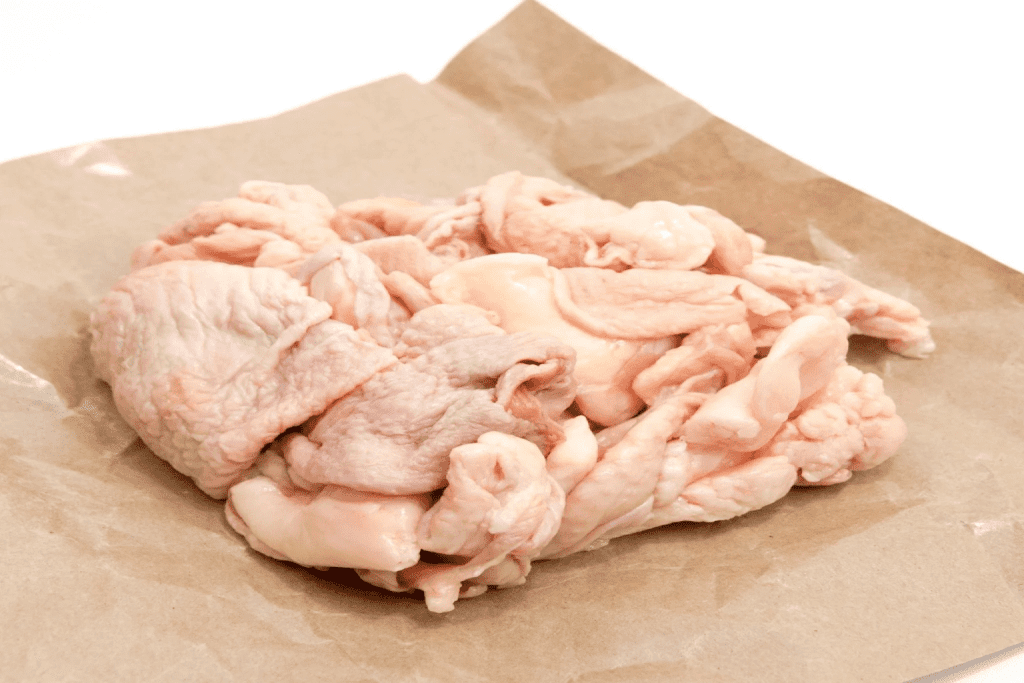Chicken is a staple food in many households across the globe, praised for its versatility, taste, and nutritional value. However, not all parts of the chicken are created equal when it comes to health safety. While most of us enjoy chicken without a second thought, some parts of the bird are known to contain parasites and harmful bacteria that can pose potential health risks if consumed. Shockingly, many people still eat these parts regularly, often unaware of the risks involved.
In this article, we’ll explore four specific parts of the chicken that are best avoided, even though they are commonly consumed.

1. Chicken Skin – A Tasty But Risky Part
For many people, chicken skin is the tastiest part of the bird. Its crispy, golden texture adds a delightful crunch, especially when roasted or fried. However, beneath its savory appeal lies a significant health concern. Chicken skin contains a lot of fat, and if not thoroughly cleaned and cooked, it can harbor parasites, bacteria, and germs.
The fat content in chicken skin makes it a breeding ground for bacteria if not handled properly. Worse still, skin that hasn’t been cleaned thoroughly can retain harmful microbes, including Salmonella and Campylobacter, which are common causes of food poisoning. These bacteria can lead to gastrointestinal issues, vomiting, and diarrhea.
What to do: If you love chicken skin, make sure it’s properly cleaned and cooked at high temperatures. Avoid consuming undercooked chicken skin, and limit your intake due to its high-fat content.
2. Parsons’ Nose (Pygostyle) – Packed with Lymphoid Tissue
The parsons’ nose, also known as the pygostyle, is the fatty, fleshy tail part of the chicken that many people enjoy for its rich, distinct flavor. However, this seemingly innocent part of the bird can carry more than just flavor.
The parsons’ nose contains a lot of lymphoid tissue, which may host pathogenic bacteria and viruses. This tissue is part of the chicken’s immune system, and it can trap harmful organisms that the bird has been exposed to. Consuming this portion increases the risk of ingesting germs and viruses, potentially leading to infections.
What to do: If you’re a fan of the parsons’ nose, consider avoiding it altogether. The risks outweigh the benefits, especially when other parts of the chicken offer flavor without these hazards.
3. Chicken Lungs – Harboring Parasites and Germs
Chicken lungs, like the lungs of many animals, are designed to filter and cleanse the body. Because of this function, they can accumulate parasites, germs, and toxins, making them one of the more dangerous parts to consume. Even after cooking, some parasites and harmful microorganisms may survive, posing a health risk.
Lungs are part of the bird’s respiratory system, and they can easily retain bacteria like E. coli and other pathogens that are difficult to kill during cooking. Consuming chicken lungs may lead to stomach pain, nausea, and other digestive issues.
What to do: It’s best to avoid chicken lungs, as they carry unnecessary risks. Opt for safer, more conventional cuts of chicken like breasts, thighs, or drumsticks, which are less likely to harbor harmful parasites.
4. Chicken Head – A Unique Flavor with Hidden Dangers

In some cultures, chicken heads are considered a delicacy, often eaten for their distinct flavor and texture. However, chicken heads can be particularly dangerous because they may contain germs, parasites, and heavy metals that accumulate in the bird’s body over time. These toxins can have adverse effects on health, especially in children, who are more vulnerable to these contaminants.
Chicken heads are more likely to contain lead, mercury, and other heavy metals that can have long-term health impacts. Ingesting these toxins over time can lead to conditions like neurological damage, kidney problems, and developmental issues in children.
What to do: Avoid consuming chicken heads, especially if you’re feeding them to young children. The health risks from potential toxins and bacteria are too significant to ignore.
Why These Chicken Parts Pose Health Risks
You might be wondering why these particular parts of the chicken are more likely to contain parasites, bacteria, or heavy metals. The reason lies in the function and anatomy of these parts. Internal organs like lungs and heads are involved in filtering toxins and waste from the body, so they naturally accumulate more harmful substances. In addition, lymphoid tissues, as found in the parsons’ nose, are part of the immune system and trap pathogens the bird may have been exposed to.

What You Can Do to Stay Safe
- Choose Safer Cuts: Stick to commonly consumed parts of the chicken, like breasts, thighs, wings, and drumsticks. These cuts are not only more nutritious but also less likely to harbor harmful bacteria and parasites.
- Practice Proper Cooking: Always cook chicken thoroughly, ensuring that it reaches an internal temperature of 165°F (75°C) to kill any harmful bacteria. Avoid eating undercooked or raw chicken, as it can increase your risk of foodborne illnesses.
- Clean and Sanitize: Wash your hands, utensils, and surfaces thoroughly after handling raw chicken. Cross-contamination is a leading cause of foodborne illness, so keep raw chicken away from other foods.
- Limit High-Risk Foods: If you’re used to eating parts like chicken skin, parsons’ nose, lungs, or heads, consider limiting or avoiding these altogether. The health risks are significant, and the nutrients found in these parts can easily be obtained from safer cuts of chicken.
Conclusion: Be Cautious with What You Eat

While chicken is a versatile and healthy source of protein, not all parts of the bird are safe to eat. Chicken skin, parsons’ nose, lungs, and heads may contain parasites, harmful bacteria, and toxins that can cause health problems. Being aware of these risks allows you to make better choices when preparing and consuming chicken.
By sticking to safer, more conventional cuts and following proper cooking guidelines, you can continue enjoying chicken without worry. Always prioritize food safety to protect your health and the health of your family.



